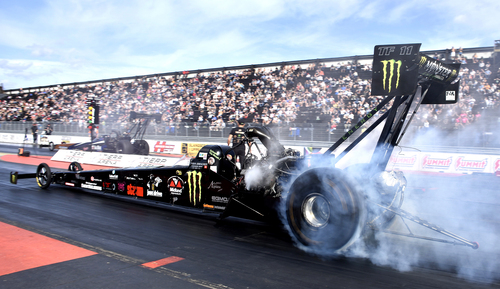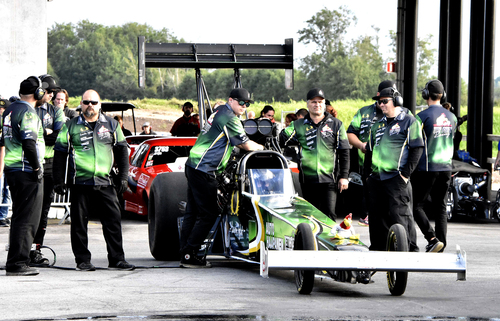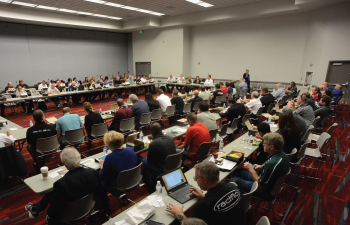INTERNATIONAL
Drag Racing, European Style
Opportunities for U.S. Racing Suppliers
By Linda Spencer

underway with May kick-off events scheduled for both the
sportsman division—the Summit Racing EDRS Series —and
the FIA European Drag Racing Championship. “Racers have
been waiting a very long time now for the return of a normal
race calendar [following the 2020 season disruption due to
COVID], and we expect a strong 2021 season,” noted Nils
Lagerlof, CEO of Speedgroup, the Swedish-based
administrator and promotion entity of both the Championship
series as well as the Summit Racing EDRS Series.
Photo courtesy: Lena Pena, Speedgroup
The European drag-racing season is set to finally get underway, with May kick-off events scheduled for both the sportsman division—the Summit Racing EDRS Series—and the FIA European Drag Racing Championship.
“Racers have been waiting a very long time for the return of a normal race calendar [following the 2020 season disruption due to COVID], and we expect a strong 2021 season,” said Nils Lagerlof, CEO of Speedgroup, the Swedish-based administrator and promotion entity of both the Championship series and the Summit Racing EDRS Series.
The Summit Racing EDRS Series is held primarily in the Nordic countries of Norway, Sweden and Finland (with a round in nearby Estonia), and it is expected to attract about 700 teams this year, similar to the number of teams in 2019. But all bets are off regarding the number of spectators.
“While the sportsman grassroots series typically attracts up to 4,000 spectators at an event, it’s really hard to guess the number of spectators we will see in 2021 because it has a lot to do with how the COVID vaccination process is advancing in Europe and if there are restrictions at the various venues remaining in place,” Lagerlof said.
Likewise, the Championship series—with 80 teams that attract up to 8,000 spectators at each round of the six-round series—may also be affected by COVID restrictions.
“Currently, there are different COVID-related restrictions in the countries hosting championship rounds,” Lagerlof said. “The first event is in the end of May at Santa Pod, England, and no one knows what the COVID situation will be by then.”

two of the six FIA Drag Racing Championship rounds. Jim
Greenleaf, Summit Racing Equipment’s motorsports and event
manager who represents his company at the title series
Summit Racing EDRS Series, commented on the synergy
between the European and U.S. drag-racing scenes. “At Tierp
[the Swedish drag arena], I was struck by how closely and
passionately the Swedish fans follow NHRA drag racing.
Everywhere you look you see Las Vegas Motor Speedway and
Charlotte Speedway hats and T-shirts and other gear. You
really wouldn’t know you are in Sweden if not for the accent.”
Photo courtesy: Lena Pena, Speedgroup
Speedgroup was founded in 2006 by a small group of race teams active in the European Drag Racing Championships. It sponsors a contingency program to connect U.S. and other manufacturers with the racers and fans in the sportsman division and through a Speedgroup subsidiary, DRE, to serve as a similar bridge for the Championship series. Speedgroup AB is currently a shareholder company registered in Sweden. The majority of the shareholders are active racers in the Championship and EDRS series.
SEMA News recently spoke with several U.S. companies that work closely with Speedgroup and have developed ongoing strong ties with European racers and fans and lend support to the growth of the European drag-racing scene. All are eager for racing to resume.
Jim Greenleaf, Summit Racing Equipment’s motorsports and event manager, represents his company at the Summit Racing EDRS Series. He commented on the synergy between the European and U.S. drag-racing scenes.
“At Tierp [the Swedish drag arena], I was struck by how closely and passionately the Swedish fans follow NHRA drag racing,” Greenleaf said. “Everywhere you look, you see Las Vegas Motor Speedway and Charlotte Speedway hats and T-shirts as well as other gear. You really wouldn’t know you are in Sweden if not for the accents.”
He noted that the sportsman grassroots division is the best fit for Summit.
“We can provide the full range of products and services for the sportsman-level racers,” Greenleaf noted. “In addition to our company making the commitment to support the racing scene in Europe, it provides the opportunity for us to learn how to service these customers. We focus not only on delivering the products but also on how to do so as efficiently and cost-effectively as possible, as we also work out issues such as taxes, tariffs and shipping to get the products from the United States to our European customers.”
VP Racing Fuels is another U.S. company that is very active in the European drag-racing scene. SEMA News recently caught up with Peter Coleman, who is in charge of European business development for the company, which is based in San Antonio, Texas.

Championship rounds and 4,000 at the Sportsman Summit
Racing EDRS series. Due to possible COVID restrictions this
year, the number of spectators allowed at any of the events is
unknown.
Photo courtesy: Lena Pena, Speedgroup
“We’ve had a deal with Speedgroup/EDRS since 2017, and along with our long-standing deal with Santa Pod in the United Kingdom, the relationship as the official fuel to Speedgroup serves to bring VP Racing Fuels closer to the racers who need our fuels and expertise,” he said. “Drag racers know that VP is available at the circuits.
“Our network of dealers and distributors is strong—particularly across Scandinavia and the United Kingdom—and there should be no need for racers to carry fuel long distances across borders, potentially breaking laws on the way. Our network, including Old Hall Performance in the United Kingdom, Ljungdahl Racing and JAMS AB in Sweden, Lindtek in Denmark, Fannrem Motorverksted in Norway and Specialty Engineering in Finland, are supported by the contingency program and should be able to get racing fuel to any location.”
We also spoke with San Diego-based SFI Foundation President Jennifer Faye about SFI’s involvement and support of European drag racing.
“We work closely with the FIA European Drag Racing Championship, the EDRS and other race organizations and federations throughout Europe,” Faye said. “SFI specifications are utilized in European drag-race rules to ensure that racing and safety equipment is tested and manufacturer-certified to the minimum standards. That ensures performance quality of the certified items and helps prevent part failures while in use.

awaiting inspection at a Swedish
speed shop. “SFI specifications are
utilized in European drag-race rules to
ensure that race and safety equipment
is tested and manufacturer-certified
to the minimum standards,” said
Jennifer Faye of SFI Foundation. “This
ensures performance quality of the
certified items and helps prevent part
failures while in use. SFI also assists
with the inspection process and
recertification of parts. Many SFI
specs require the parts to be
inspected periodically to check for
damage, undue wear or other
conditions that could harm the
integrity of the part and prevent it
from performing as intended, or failing
and causing a safety problem. Most of
the ‘hard parts’ manufacturers are in
the United States, and shipping heavy
parts overseas for inspection can be
very expensive. So, we bring the
factory- trained inspectors to the
racers in an effort minimize cost for
them. We have been conducting SFI
inspections in the springtime before
each race season for more than 20
years. During the pandemic, our
normal inspection tour has been
interrupted, but we have evolved our
team of inspectors to be comprised of
Europe-based technicians who have
been able to carry on the inspections
locally to coordinate the process from
here in the United States.”
Photo courtesy: Jennifer Faye, SFI Foundation
“SFI also assists with the inspection process and recertification of parts. Many SFI specs require the parts to be inspected periodically to check for damage, undue wear or other conditions that could harm the integrity of the part and prevent it from performing as intended or failing and causing a safety problem. Most of the hard-parts manufacturers are in the United States, and shipping heavy parts overseas for inspection can be very expensive, so we bring factory-trained inspectors to the racers in an effort to minimize cost for them. We have been conducting SFI inspections in the springtime before each race season for more than 20 years.
“During the pandemic, our normal inspection tour has been interrupted, but we have evolved our team of inspectors to be comprised of Europe-based technicians who have been able to carry on the inspections locally, with us coordinating the process from here in the United States. In addition to the annual parts inspections, we provide technical assistance with SFI specs using their regulations as well as providing a certification exam program for SFI International Technical Inspectors/Scrutineers.”
The ties with U.S. drag racing and the opportunities for U.S. racing supplies are deep, according to Speedgroup and the U.S. firms SEMA News spoke with. Speedgroup works closely and intensively with its partners at competitions and other events.
“In addition to the competitions we participate in and promote with our partners, we also work with fairs and other events,” Lagerlof said. “In 2019, Speedgroup met about 200,000 potential customers on seven trade fairs and events. Together with the audience of about 250,000 people at our competitions, our partners are seen as an attractive way toward a good target group.”
“There is a deep appreciation of American car culture there that keeps drag racing strong across European borders,” Faye said. “In addition to the American car models you typically see, you also have the opportunity to watch cars go down the track that are unique to Europe. One example is the Ford Anglia nostalgic gassers in the United Kingdom. They are serious race cars, running in the sevens at almost 200 mph, and they are very different looking from the types of cars we have here, but what’s under the body can be similar.”
That was seconded by Summit Racing’s Greenleaf.
“The enthusiasm in Europe for American musclecars is incredible and evident on European race tracks,” he said. Greenleaf also noted that American cars and equipment find their way from the United States to Europe, and that creates huge opportunities for U.S. motorsports manufacturers.
SFI Foundation’s Faye also estimated that about 95% of certified hard parts used in European drag racing are from the United States.
“Many of the cars raced in Europe are American-based models, so there’s a market for American parts, whether it’s drivetrain or safety equipment,” Faye said. “Of course, there are several safety-equipment manufacturers in Europe for sourcing personal protective gear, but drag-race-specific items such as supercharger restraints are solely produced in the United States, and there is a need for that equipment across the pond.
“Particularly with safety equipment, the one area we are always trying to expand in Europe is customer service and support. I would suggest that if there were U.S. companies that would like to enter this market, they should connect with a local supplier or retailer in a particular country that they want to be in, whether it’s Sweden, Finland, the United Kingdom or elsewhere. Having local knowledge is invaluable, and setting up a relationship with a supplier who can help you communicate and offer technical service and support to local racers goes a long way in gaining loyal customers.”
There is more drag racing happening in Europe than most people outside of Europe probably realize, ranging from sportsman club racing all the way up to professional classes. An interesting thing to note is that the ProMod class is very prolific and extremely popular there, just as it is in the United States. Drag-race fans and competitors in Europe are very passionate about their sport.
“While we have a longer season in the United States, with more stops and more racers, there are smaller groups of drag racers and enthusiasts in Europe,” Coleman said. “But their depth of passion is no less than you’d get in the United States.”
 2021 SEMA NORDIC TRIP
2021 SEMA NORDIC TRIP
SEMA is hosting the first SEMA Nordic trip taking place in August in Stockholm, Sweden. Grants are available to help defray the participation costs. Meet pre-vetted buyers and see the market first-hand.
For more information on the 2021 SEMA Nordic trip, visit
www.sema.org/nordic or contact Linda Spencer at lindas@sema.org.








